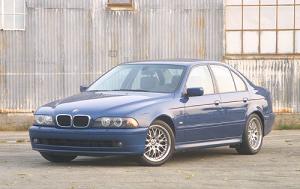The BMW 5-Series has been the standard-bearer when it comes to premium sport sedans and wagons for a long time. Making its debut in the U.S. in 1972, the 5-Series quickly earned a superlative reputation for its appealing combination of performance, luxurious features, and interior roominess.
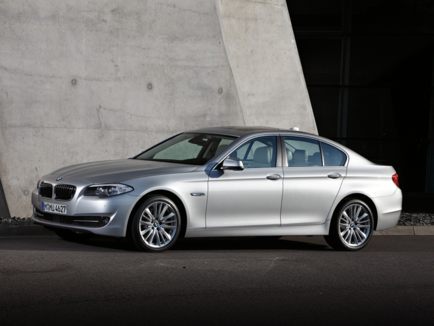
But now, historically high new and used car prices have forced many buyers to look for "older" vehicles that have aged well as a way of saving money. This has made the issues of reliability and dependability even more crucial.
How about older BMW 5-Series models? Have they proven to be reliable? And by older, I'm referring to models generally 10+ years old, so those from the fifth and sixth 5-Series generations, produced from 2004 - 2016.
And for consumers shopping for an older 5-Series, it's important to know that their history for reliability is mixed. Some owners have had positive experiences long-term, but there are others who have run into problems.
Another important factor is that they are expensive to maintain and repair, and this needs to be budgeted for as well, just in case. They may be solidly built, but they are also highly-engineered and complex, making both parts and labor expertise more costly than non-luxury brands when needed.
In addition, how reliable a specific older 5-Series actually is can also vary greatly depending on how well the vehicle has been maintained, its mileage, the driving habits of the owner, and the driving conditions its been subjected to. And then throw it a little luck as well.
All that said, history has proven that a properly cared for older 5-Series can last in the 150,000 - 200,000 mile range, while there are also reports of some doing 300,000+, so there is indeed upside.
Again, these are the "properly cared for" models. And these are the ones you need to identify before buying today. This doesn't guarantee anything, but it will put the odds much more in your favor.
See more on this in the Possible Mechanical Problems sections below.
So here, ...
- We'll do an overview of earlier BMW 5-Series generations, specifically the fifth and sixth, covering the 2004 - 2016 model years.
- Then we'll list possible mechanical issues that have been reported by some owners for each generation so they can be checked before buying today.
- And then we'll summarize the overall pros and cons of an older 5-Series worth consideration for potential buyers.
But first, and very importantly ...
Things To Do When Considering An "Older" 3-Series
Locate Lower Mileage Vehicles: They are certainly out there to be found with careful and patient shopping. Be willing to drive a distance if you have to.
Vehicle History and Maintenance: Ask for the vehicle history report (CarFax or AutoCheck) as well as documented maintenance and repair records. If not provided by the Dealer or private seller, it's usually best to move on.
Pre-Purchase Inspection: Have the vehicle independently inspected before making a final decision. This usually will cost in the $200 range but is well worth it given the potentially thousands in savings over the long term.
And My #1 Price Tip: Please, always get online price quotes at auto sites such as CarsDirect.com and Edmunds.com (both, actually), whether looking for a new or used car. Competition among dealers for your business does amazing things to prices, and it's so easy. It really does make a difference.
And quickly, while we're at it, my #2 Tip is to always know the up-to-date trade-in value of your current car. You can get a quick and surprisingly accurate one at Edmund's Trade-In Quotes.
It's free and just takes a couple of minutes. I think what helps its accuracy is the inputs will include either your plate# or VIN# followed by many simple, but specific, yes/no questions. It really focuses in on the detail of the specific vehicle.
2011 - 2016 BMW 5-Series (Sixth Generation)
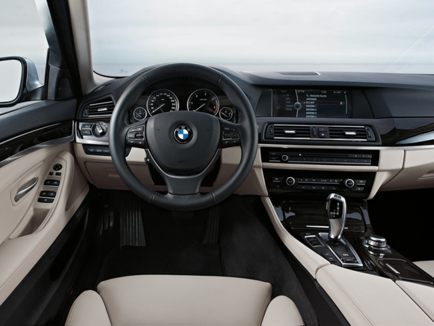
The BMW 5-Series offers a downright amazing balance of both riding comfort and athletic handling, being equally adept at aggressively handling those back twisty roads as it is being a comfortable daily commuter and/or smoothing out rough highways.
And the sixth generation was certainly no exception. In fact, it became the most popular in 5-Series history with over 2 million sold, and remains a sought-after used model today.
New for this version was a power boost all around. The 528i's 3.0-liter straight-6 added 10 horsepower, to 240, and a new turbocharger design in the 535i's 3.0-liter straight-6 increased both low-end torque and fuel efficiency while keeping the same horsepower.
The biggest change, however, was with the 550i, which was upgraded with the 7-Series' 400-horsepower 4.4-liter turbo V8.
Also new was an 8-speed automatic transmission that increased both acceleration and gas mileage over the previous 6-speed automatic, while the manual transmission was still available on all models. Other upgrades borrowed from the 7-Series included its electric-assist steering rack and multilink front suspension.
This version is also both slightly wider and longer than its predecessor, and added about 300 pounds. And new available features included top and side-view cameras, a significantly improved iDrive system, a head-up display, an automated parallel parking system, and a blind-spot alert system.
For the 2012 model year, there was a minor update to exterior trim and interior materials and the F11 Touring (wagon) was introduced.
In 2013, the 5-Series saw the introduction of the ActiveHybrid 5 model, featuring a hybrid powertrain for improved fuel efficiency. The iDrive system was again upgraded with enhanced functionality and an improved user interface.
For the 2014 model year, there were some minor exterior and interior updates, including revised front and rear styling elements. Also, there was the introduction of the 550i xDrive model with all-wheel drive (AWD) capability.
For 2015, the LCI (Life Cycle Impulse) got a refresh, featuring updated styling elements such as revised front and rear bumpers, LED headlights, and LED taillights. Additional driver assistance features, including active lane-keeping assist and traffic jam assistant were introduced.
2011 - 2016 BMW 5-Series Possible Mechanical Problems
The sixth generation BMW 5-Series, the F10, has had mechanical issues reported by owners that should therefore be included in an inspection prior to buying. The more common include:
Timing Chain Tensioner Failure: One of the more significant issues involves timing chain tensioner slack, which can lead to engine damage and potential catastrophic failure. This problem has been more prevalent in early production models.
Car Buying Tips:
Best Time To Buy And Negotiate
Best Used Cars For Reliability
High-Pressure Fuel Pump (HPFP) Issues: Some F10 models equipped with turbocharged engines experienced problems with the high-pressure fuel pump, including include rough idling, engine hesitation, and stalling. BMW issued several recalls and extended warranty coverage for affected vehicles.
Cooling System Problems: Like its predecessor below, this 5-Series had reported issues with the cooling system, including water pump failures and coolant leaks.
Transmission Failures: Some models equipped with automatic transmissions experienced transmission issues, including rough shifting, hesitation, and premature failure.
Electrical System Gremlins: As with many modern vehicles, the F10 experienced occasional electrical problems, including issues with sensors, modules, and electronic components. These issues could manifest as warning lights on the dashboard, malfunctioning accessories, or intermittent electrical failures.
Turbocharger Problems: Some turbocharged engines experienced issues with the turbochargers themselves, including failure or excessive wear over time.
Oil Leaks: Oil leaks from various engine seals and gaskets were reported in some models, similar to the issues seen in the previous generation. Common areas prone to leaks include the valve cover gaskets, oil filter housing gasket, and oil pan gasket.
Suspension and Steering Components: Some owners experienced issues with suspension components such as control arms, bushings, and ball joints. Additionally, there were reports of problems with the electric power steering system, leading to steering stiffness or failure.
It should be noted, as with any vehicle, proper maintenance and timely repairs may have helped mitigate or prevent these problems in many vehicles. Purchasing a well-maintained vehicle with a comprehensive service history can reduce the likelihood of encountering these issues.
2004 - 2010 BMW 5-Series (Fifth Generation)
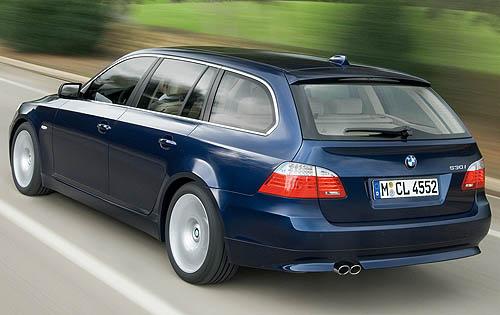
In addition to its exceptional driving manners, this 5-Series possessed one of the roomiest and comfortable interiors in its class, especially so for those outfitted with the optional multicontour front seats.
For the 2004 and 2005 model years, this 5-Series was a rear-wheel-drive sedan only. The models consisted of two six-cylinder choices, the 2.5-liter 184-horsepower 525i and the 3.0-liter 225-horsepower 530i, as well as a V8 model, the 4.4-liter 325-horsepower 545i.
The standard transmission during the whole generation was a 6-speed manual transmission, however, the vast majority were outfitted with the optional 6-speed automatic.
The engine lineup was revised for the 2006 model year with both 6-cylinders getting a more powerful 3.0-liter engine that was good for 215-horsepower in the 525i and 255-horsepower in the 530i. The top-line sedan was given a 360-horsepower 4.8-liter V8 and became the 550i.
Also making an entry in 2006 was the all-wheel-drive 5-Series wagon, the 530xi. All-wheel drive also became an available option for the 530 sedan.
For the 2007 model year, additional standard features were added, including BMW Assist and an auxiliary input jack. And 5-Series models from 2007 can also be found with new optional features that included 20-way adjustable front seats, a night vision system, and high-definition radio.
The 6-cylinder engines were again replaced for the 2008 model year. The base model became the 528i and came with a 3.0-liter inline-6 that was good for 230-horsepower. The midlevel model became the 535i with a twin-turbo 3.0-liter inline-6 that produced 300-horsepower.
In addition, the xDrive all-wheel-drive system also became an option on both 528i and 535i sedans, while the wagon was available in 535i xDrive form only.
Older BMW 5-Series shoppers should also note that the electronic iDrive interface via a control-dial on the console and a central LCD screen, was confusing and non-intuative even for many fairly simple tasks. The control knob and menu buttons were updated for 2009 but the user-unfriendly menu features stayed the same.
2010 models then got an updated and much improved system, but only on those equipped with the navigation system. The next generation, kicked off in 2011, vastly improved the system.
2004 - 2010 BMW 5-Series Possible Mechanical Problems
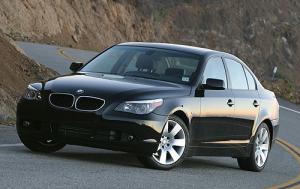
The fifth generation BMW 5-Series, the E60, also had mechanical issues reported by owners that should therefore be included in a pre-purchase inspection. The more common include:
Engine Cooling System Issues: The E60 experienced problems with its engine cooling system, including issues with the water pump and thermostat. These issues could lead to overheating and potential engine damage if not addressed promptly.
Electrical System Failures: Electrical gremlins were reported in some models, including issues with various sensors, modules, and electronic components.
Suspension Components: Some owners experienced issues with the suspension components, including worn bushings, control arms, and ball joints. These problems could result in excessive noise, vibrations, or uneven tire wear.
Transmission Problems: Some models equipped with automatic transmissions, particularly the early years, had reports of transmission issues such as rough shifting, hesitation, or premature failure.
Fuel Delivery System: Fuel pump failures were reported in some models, leading to symptoms such as engine hesitation, stalling, or difficulty starting.
Brake System Concerns: Some owners experienced premature wear of brake components, including brake pads and rotors. Additionally, there were reports of brake vacuum pump failures, which could affect braking performance and safety.
Oil Leaks: Oil leaks from various engine seals and gaskets were reported by some owners. Common areas prone to leaks include the valve cover gaskets, oil filter housing gasket, and oil pan gasket.
It's important to note that not all E60 models will experience these problems, and regular maintenance and timely repairs can help mitigate potential issues.
Pros And Cons Of An Older BMW 5-Series
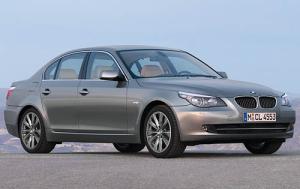
Older BMW 5-Series Pros
Cost Savings: Not surprisingly, older 5-Series models generally have lower purchase prices compared to newer ones, providing potentially significant cost savings upfront.
Strong Value Potential: Given the depreciation curve of luxury vehicles like the BMW 5-Series, older models may offer excellent value for the money. Buyers may find well-maintained examples with relatively low mileage at attractive prices.
Classic Styling: Some buyers appreciate the classic styling of older BMW models, such as the E60 or F10. These designs have aged gracefully and still offer a premium and timeless aesthetic.
Performance and Driving Dynamics: Despite being older, older 5-Series are still known for their engaging driving dynamics and performance-oriented characteristics. They offer a balance of sportiness and comfort, making them enjoyable to drive.
Innovative Technology: Older 5-Series models were equipped with various advanced technologies for its time, including the iDrive infotainment system, adaptive headlights, active cruise control, and active steering. These features enhanced convenience, safety, and driving experience.
Powerful Engine Options: The E60 offered a range of powerful engine choices, including inline-four, inline-six, V8, and even a high-performance V10 engine in the M5 variant. These engines provided impressive performance and acceleration.
Bold Design: The E60 featured a bold and distinctive design, characterized by its aggressive front fascia, sweeping lines, and muscular stance. While somewhat polarizing, it made a statement on the road and set it apart from its competitors.
Older BMW 5-Series Cons
Maintenance and Repair Costs: Older vehicles typically require more maintenance and repairs as components wear out over time. BMWs, in particular, can be expensive to maintain, especially when it comes to parts and labor costs for repairs.
Reliability Concerns: Both the E60 and F10 generations have had reported reliability issues, ranging from engine-related problems to electrical gremlins. While some issues may have been addressed through recalls or service bulletins, potential buyers should be aware of the potential for unexpected repairs.
Fuel Efficiency: Older 5-Series models may not be as fuel-efficient as newer ones, especially if equipped with larger, more powerful engines. This could result in higher fuel costs over time, particularly if a buyer has a long commute or drives frequently.
Outdated Technology: Despite its advancements, compared to newer models, older 5-Series vehicles may lack some of the latest technology features and safety advancements. This could include infotainment systems, driver assistance features, and connectivity options that have become standard in more recent vehicles.
Less Engaging Handling: While still capable, the sixth generation was criticized by some enthusiasts for its less engaging driving dynamics compared to the fifth.
Styling Controversy: Although less radical than its predecessor, the sixth generation's design also received mixed reviews, with some finding it less distinctive compared to rivals.
Electronics Complexity: While improved for the sixth generation, some drivers still found the iDrive system and other electronic features to be complex and potentially distracting.
Interior Quality: While the interior of the fifth generation 5-Series was generally well-appointed and comfortable, some considered the interior design and quality to be lacking compared to other luxury sedans in its class.
 By Josh Rosenberg
By Josh Rosenberg